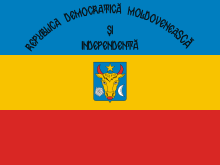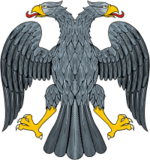Russian Democratic Federative Republic
| Russian Wikisource has original text related to this article: |
The Russian Democratic Federative Republic (Russian: Российская Демократическая Федеративная Республика[1] transliteration: Rossiyskaya Demokraticheskaya Federativnaya Respublika) was a proposed federal form of government of Russia during the Russian Revolution of 1917. It was formally declared on 19 January 1918 [2] when the democratically elected Russian Constituent Assembly drafted and adopted the "Resolution on the form of government of Russia", declaring Russia to be a democratic federal republic. However, the Assembly was dissolved on the same day by the All-Russian Central Executive Committee, thus making the Republic the shortest-lived state in history.
Governmental structure
According to the constitution, Russia was declared a democratic federal republic. The fundamental basis of the state was representative democracy and federation of both[3] national and territorial autonomous oblasts.[4] This was in contrast to the Decembrist constitution project, which proposed a federal constitutional monarchy on an economic basis. For the first time, the unitary structure of Russia was officially abolished and the country was declared a federation, marking the start of the federalist period in Russian history.[2]
Civil rights and duties
The Constitution granted universal suffrage for all citizens of Republic aged 20 or older.[5] This was five years lower than in the former Russian Empire.
Most civil duties, such as conscription and taxes, were inherited from the legislation of the Russian Empire.
Head of state
The head of state was the President of the Russian Democratic Federative Republic, elected for a one-year term[5] by a majority vote in parliament involving the deputies of both chambers.[4] Presidential powers were nearly identical to those of the Emperor:[5]
- Appointment of several government officials and their removal of office;
- Commander-in-chief of the Russian Army;
- Decisions on the foreign policy of Russia;
- Right to propose laws;
- Control over governmental structures member and functioning;
- Control over law enforcement;
- Exercising and overseeing management in Russia.
The President was responsible for his work before the parliament. A similar approach to presidential power was later used in the German constitution of 1919.
Due to the cancellation of the Constitution, no person was ever elected to this office.
Legislation
According to the final draft of the Constitution, adopted in Paris on 20 January 1920, legislative power was to be held by a bicameral parliament. The State Council of the Russian Democratic Federative Republic would form the upper house, elected by regional legislatures (sejms),[4] while the State Duma of the Russian Democratic Federative Republic would form the lower house, directly elected by citizens of the Republic.[4]
Constituent powers to create a new constitution and change the type of government were allocated to the Russian Constituent Assembly.[4]
Intended autonomies within federation
 Alash Autonomy, a self-proclaimed autonomy (December 1917) that declared independence a year later (13 December 1918).
Alash Autonomy, a self-proclaimed autonomy (December 1917) that declared independence a year later (13 December 1918). Autonomous Governorate of Estonia, already established as autonomy. Declared itself independent as the Republic of Estonia on 23 February 1918.
Autonomous Governorate of Estonia, already established as autonomy. Declared itself independent as the Republic of Estonia on 23 February 1918. Moldavian Democratic Republic, declare autonomous on 15 December and independent on 6 February 1918.
Moldavian Democratic Republic, declare autonomous on 15 December and independent on 6 February 1918. Transcaucasia, whose autonomy was recognised by the Special Transcaucasian Committee (OZAKOM) of the Russian Provisional Government in 1917. Declared independence as the Transcaucasian Democratic Federative Republic on 24 February 1918. Subsequently split into:
Transcaucasia, whose autonomy was recognised by the Special Transcaucasian Committee (OZAKOM) of the Russian Provisional Government in 1917. Declared independence as the Transcaucasian Democratic Federative Republic on 24 February 1918. Subsequently split into:
.svg.png) Democratic Republic of Georgia, from 26 May 1917.
Democratic Republic of Georgia, from 26 May 1917. Democratic Republic of Armenia, from 28 May 1917.
Democratic Republic of Armenia, from 28 May 1917. Azerbaijan Democratic Republic, from 28 May 1917.
Azerbaijan Democratic Republic, from 28 May 1917.
 Ukrainian People's Republic, whose autonomy recognised on 26 June 1917. Became an autonomous republic on 20 November 1917 before declaring itself independent on 25 January 1918.
Ukrainian People's Republic, whose autonomy recognised on 26 June 1917. Became an autonomous republic on 20 November 1917 before declaring itself independent on 25 January 1918. Idel-Ural State, whose autonomy was proclaimed on December 12, 1917, by a Congress of Muslims from Russia's interior and Siberia. Defeated by Red Army on March 1918.
Idel-Ural State, whose autonomy was proclaimed on December 12, 1917, by a Congress of Muslims from Russia's interior and Siberia. Defeated by Red Army on March 1918.
See also
References
- 1 2 (Russian) Decree on system of government of Russia
- 1 2 3 http://www.prof.msu.ru/publ/book/round1.htm
- ↑ (Russian) Гаранжа, Анатолий Петрович Всероссийское Учредительное собрание о государственном устройстве страны
- 1 2 3 4 5 (Russian) THE POLITICAL SYSTEM OF RUSSIA IN PROGRAMS OF WHITE MOVEMENT AND WHITE EMIGRATION Bukhvostovoj D.V.
- 1 2 3 (Russian) Details on 1917 project of the constitution of the Russian Democratic Federative Republic //LAW.EDU.RU

